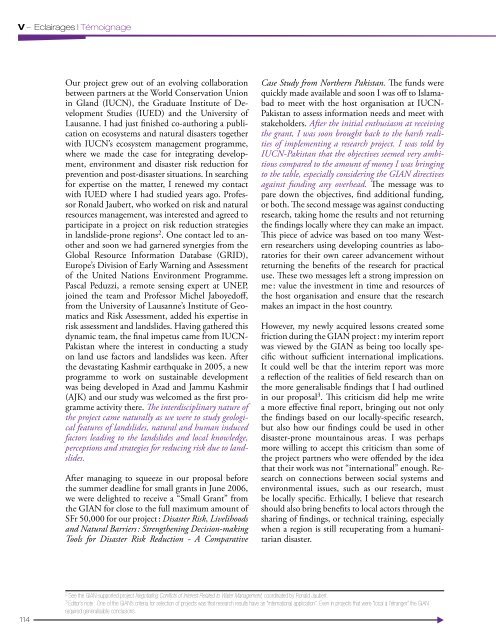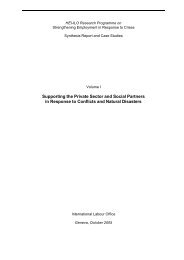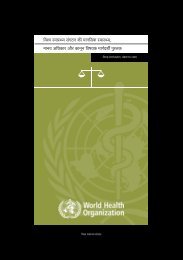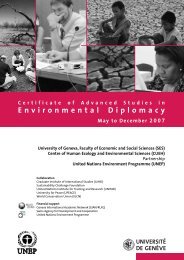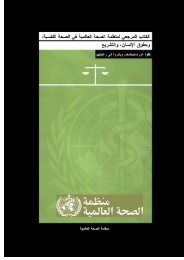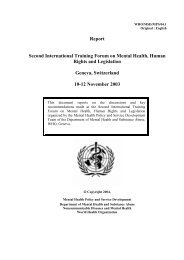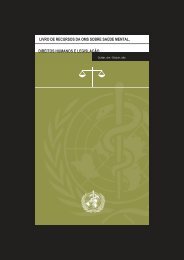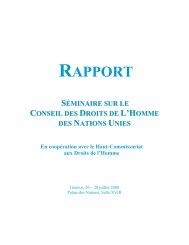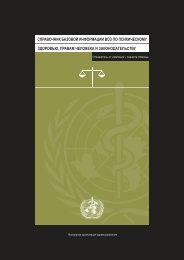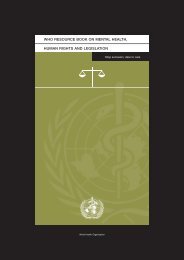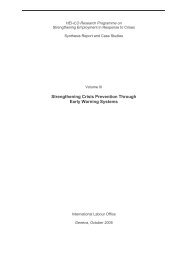Les liaisons fructueuses - RUIG-GIAN
Les liaisons fructueuses - RUIG-GIAN
Les liaisons fructueuses - RUIG-GIAN
You also want an ePaper? Increase the reach of your titles
YUMPU automatically turns print PDFs into web optimized ePapers that Google loves.
V – Eclairages | Témoignage<br />
Our project grew out of an evolving collaboration<br />
between partners at the World Conservation Union<br />
in Gland (IUCN), the Graduate Institute of Development<br />
Studies (IUED) and the University of<br />
Lausanne. I had just finished co-authoring a publication<br />
on ecosystems and natural disasters together<br />
with IUCN’s ecosystem management programme,<br />
where we made the case for integrating development,<br />
environment and disaster risk reduction for<br />
prevention and post-disaster situations. In searching<br />
for expertise on the matter, I renewed my contact<br />
with IUED where I had studied years ago. Professor<br />
Ronald Jaubert, who worked on risk and natural<br />
resources management, was interested and agreed to<br />
participate in a project on risk reduction strategies<br />
in landslide-prone regions 2 . One contact led to another<br />
and soon we had garnered synergies from the<br />
Global Resource Information Database (GRID),<br />
Europe’s Division of Early Warning and Assessment<br />
of the United Nations Environment Programme.<br />
Pascal Peduzzi, a remote sensing expert at UNEP,<br />
joined the team and Professor Michel Jaboyedoff,<br />
from the University of Lausanne’s Institute of Geomatics<br />
and Risk Assessment, added his expertise in<br />
risk assessment and landslides. Having gathered this<br />
dynamic team, the final impetus came from IUCN-<br />
Pakistan where the interest in conducting a study<br />
on land use factors and landslides was keen. After<br />
the devastating Kashmir earthquake in 2005, a new<br />
programme to work on sustainable development<br />
was being developed in Azad and Jammu Kashmir<br />
(AJK) and our study was welcomed as the first programme<br />
activity there. The interdisciplinary nature of<br />
the project came naturally as we were to study geological<br />
features of landslides, natural and human induced<br />
factors leading to the landslides and local knowledge,<br />
perceptions and strategies for reducing risk due to landslides.<br />
After managing to squeeze in our proposal before<br />
the summer deadline for small grants in June 2006,<br />
we were delighted to receive a “Small Grant” from<br />
the <strong>GIAN</strong> for close to the full maximum amount of<br />
SFr 50,000 for our project : Disaster Risk, Livelihoods<br />
and Natural Barriers : Strengthening Decision-making<br />
Tools for Disaster Risk Reduction - A Comparative<br />
Case Study from Northern Pakistan. The funds were<br />
quickly made available and soon I was off to Islamabad<br />
to meet with the host organisation at IUCN-<br />
Pakistan to assess information needs and meet with<br />
stakeholders. After the initial enthusiasm at receiving<br />
the grant, I was soon brought back to the harsh realities<br />
of implementing a research project. I was told by<br />
IUCN-Pakistan that the objectives seemed very ambitious<br />
compared to the amount of money I was bringing<br />
to the table, especially considering the <strong>GIAN</strong> directives<br />
against funding any overhead. The message was to<br />
pare down the objectives, find additional funding,<br />
or both. The second message was against conducting<br />
research, taking home the results and not returning<br />
the findings locally where they can make an impact.<br />
This piece of advice was based on too many Western<br />
researchers using developing countries as laboratories<br />
for their own career advancement without<br />
returning the benefits of the research for practical<br />
use. These two messages left a strong impression on<br />
me : value the investment in time and resources of<br />
the host organisation and ensure that the research<br />
makes an impact in the host country.<br />
However, my newly acquired lessons created some<br />
friction during the <strong>GIAN</strong> project : my interim report<br />
was viewed by the <strong>GIAN</strong> as being too locally specific<br />
without sufficient international implications.<br />
It could well be that the interim report was more<br />
a reflection of the realities of field research than on<br />
the more generalisable findings that I had outlined<br />
in our proposal 3 . This criticism did help me write<br />
a more effective final report, bringing out not only<br />
the findings based on our locally-specific research,<br />
but also how our findings could be used in other<br />
disaster-prone mountainous areas. I was perhaps<br />
more willing to accept this criticism than some of<br />
the project partners who were offended by the idea<br />
that their work was not “international” enough. Research<br />
on connections between social systems and<br />
environmental issues, such as our research, must<br />
be locally specific. Ethically, I believe that research<br />
should also bring benefits to local actors through the<br />
sharing of findings, or technical training, especially<br />
when a region is still recuperating from a humanitarian<br />
disaster.<br />
114<br />
2. See the <strong>GIAN</strong>-supported project Negotiating Conflicts of Interest Related to Water Management, coordinated by Ronald Jaubert.<br />
3. Editor’s note : One of the <strong>GIAN</strong>’s criteria for selection of projects was that research results have an “international application”. Even in projects that were “local à l’étranger” the <strong>GIAN</strong><br />
required generalisable conclusions.


